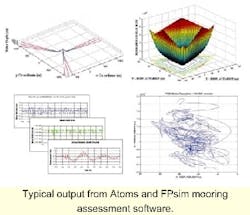FLOATING TECHNOLOGY: Analyzing bi-directional seas for FPSO design, operations
Many floating production, storage, and offloading (FPSO) vessel projects use existing ship hulls, since these provide cost and program advant-ages on fast-track marginal field developments. Second hand tankers or newly built tanker hulls are often considered. The rigors to which these hulls will be exposed as FPSOs are often far more onerous than those that would be experienced as a ship, as FPSOs are typically permanently moored in open seas.
The need to determine the suitability of a particular hull for FPSO service led Armstrong Technology to develop load analysis software, called Atlas. The company uses the software for strength and fatigue assessment of hulls, and Atoms and FPsim programs for the frequency and time domain analysis of moorings and position-keeping systems. These programs can assess the strength, fatigue and mooring aspects of a design using relatively little input and are suited to use in concept selection and appraisal of selected hulls and systems.
The programs for hull strength, fatigue assessment, and mooring system analysis were developed by Simon Coggon and Chris Hall of Armstrong Technology in partnership with Professor Atilla Incecik, head of the Marine Technology Department at the University of Newcastle. The company initially employed Coggan and Hall through the UK's Teaching Company Scheme that promotes and enables technology transfer between universities and industry.
Program specifics
The program facilitates a hydrodynamic analysis based on input of the principal characteristics of the hull and a definition of the site-specific environment. It is used to provide design-specific motion and wave-load infor-mation at an early stage, allowing hull and system designers to work with more realistic data without being unnecessarily conservative.
The analysis uses long-term prediction techniques to determine the motions; dynamic wave loads and fatigue life for the hull, which can be compared to specification requirements. A typical hull girder strength analysis takes only a few hours to run. A preliminary fatigue analysis requires a few more inputs defining the structural connection types around a hull section and a further few hours to run.
The results also identify those areas of the hull of most concern to the structural designer and help to identify the extent of required strengthening. The program operates using little input and approximates the hull shape to an equivalent barge form, thus saving significant time and effort. The technique has been validated by comparison of the results of the program to those from more sophisticated analyses of actual FPSO hulls.
Despite the high degree of correlation observed, the program can, by virtue of the modular programing technique used to create it, also accept the results of alternative hydrodynamic analyses if desired. Where a newbuild is proposed for an FPSO, Atlas provides an optimum design for a specific service. The program can be used to study sensitivity to key dimensions and thus identify optimal dimension sets.
Bi-directional seas
The program was originally developed to assess vessel responses in uni-directional environmental conditions. Several FPSO operators have been concerned by the phenomenon of bi-directional seas (two independent wave systems from different directions) causing undesirable roll motions and consequences for the hull structure and the operation of the FPSO.
The two wave systems typically comprise a wind-driven component and swell from a distant storm. Armstrong Technology developed Atlas to assess the implications of such sea conditions for the hull structural strength and fatigue life.
Separate stress response spectra are generated for each combination of wave height, period, direction and draught expected during operation. The stress responses are summed with consideration to the probability of occurrence to produce a distribution of the long-term stress levels around the hull and the expected fatigue damage.
This innovation has been used to assess the implications for the operation of the FPSO Whakaaropai operating offshore New Zealand. The work contributed to the continued safe operation of the FPSO by establishing a better understanding of the operational limits of the hull and revising operating procedures accordingly. Bi-directional sea conditions exist in many areas and are seldom taken fully into account in vessel selection or design processes.
Atoms and FPsim
To assist concept selection for vessel mooring systems these programs have been developed to use only a modest amount of input. The programs calculate the fundamental design parameters including vertical and horizontal loads at anchors, loads at fairleads and at touchdown points, mean offset and significant and maximum motion amplitudes.
Each program shares modules of code using basic inputs requiring little detailed information. Some of the program modules are also common to Atlas and considerable economy in effort has been realized coding modules in this way. The programs are ideal for use when selecting field development strategies.
Atoms provides for analysis of mooring systems in the frequency domain. Three-dimensional multi-line, multi-segment catenary systems, clump weights and taut synthetic lines can currently be assessed. Wind and current drag coefficients and reflection coefficients can be calculated automatically using the programmed empirical relationships or input by the user if more specific data is available.
Vessel responses are calculated using methods required by regulatory bodies and proposed in authoritative design guides, such as the CMPT guide for design and analysis of floating structures. The calculation routines have been validated by correlating the results with various model test results for FPSOs.
FPsim extends the capability of Atoms to look at mooring system response in the time domain. The program utilizes the mooring restoring force surface generated using Atoms and can simulate vessel and mooring system response to an input environment. It also permits user interaction through the graphical user interfaces.
The user may change the environment or the mooring system at any stage. Thus dynamic response to changing environment or mooring system breakage can be visualized and assessed. Mooring line failure due to excessive line load or FPSO offset can also be assessed by setting breakage criteria values in the input.
Ongoing development
FPsim is currently under development to include the capability to assess the performance of thruster-assisted positioning systems. The use of GUIs to interactively control the thrusters and autopilot systems is envisaged. The capability to size thruster systems and determine electrical load is the intention and the applicability of the software will therefore reach beyond moored vessels and FPSOs to other ship types requiring a dynamic positioning capability.
Innovative software coupled with sound practical shipbuilding and FPSO experience provides a formidable capability for ship and offshore structure design ideally suited to the fast track nature of today's offshore industry. The technology transfer between Newcastle University and Armstrong Technology, which has facilitated the development of the design tools, has allowed a significant advance in the technology applied to FPSO design.



